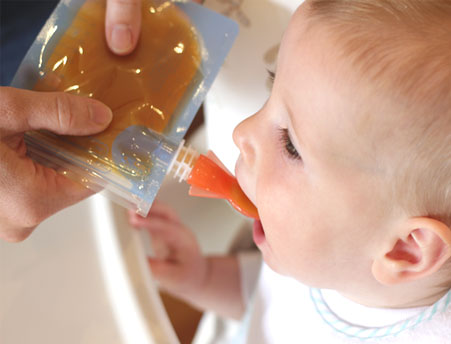Cindy Morrison, M.S., CCC-SLP, CLC
Pouch feeding.
The food pouch is everywhere. Many parents are offering food pouches more often than spoon feeding. This means that many babies are now going from breast or bottle feeding to drinking a stage 2 puree from a wide straw without making much of a mess. If you aren’t sold on buying from one of the many companies that are conveniently offering these food pouches, you now also have the opportunity to buy empty pouches to make your own at home. This new way of offering food to babies and children has created a change in the world of pediatric feeding and has the attention of Speech Language Pathologists.
A brief history of the pouch
The packaging was originally designed by NASA with intention to send it into space. The design keeps fruit fresh for months instead of days and has the added bonus of not needing to be refrigerated. Innovative marketing minds quickly grabbed a hold of this idea and translated this packaging into a version attractive to the parents of babies and children up to 6 years of age. Peter Rabbit Organics, one of the first companies to offer the pouch, was founded in the UK in 2004 and Ella’s kitchen another UK company followed closely behind them in 2006. Three years later in 2009, Plum Organics became the first U.S. company to manufacture and offer them across the nation. Plum Organics was followed by a storm of companies that now sell these pouches including Gerber.
When you research why this design was appealing to companies you find that the packaging is much cheaper than glass. It’s much lighter during production and transport which now means a huge cost savings for the makers of baby foods. In fact, all of these companies are achieving record profits from today’s generation of parents and it’s abundantly clear that the success comes down to one thing: modern convenience.
If you want to see a bit more of the company’s marketing, you can check out the story they’ve planned for you to see here. An article written by the N.Y. Times, states that Neil Grimmer, CEO of Plum Organics, and his wife were dropping their kids off at day care each morning with healthy meals and found that, even though they had put forth incredible effort, their children were not eating them. They experimented, in effort to make eating easier at day care, and discovered that their daughters preferred to eat pureed foods. This sparked the creation of the U.S. food pouch and Plum Organics. The pouch is designed to be so easy “that if you hand it to a 9 to 12 month old, they can feed themselves.” I had to shudder at this comment for many, many reasons, but my attention was still stuck on making eating easier at day care.
As a pediatric feeding therapist, I see a much bigger problem. How are meals being presented, supported and encouraged to children at day care? Are children allowed to take their time? Are they getting permission to make a mess and explore and learn about their foods? Are they sitting down to eat or are they eating on the go? The pouch is an innovative band aid on a nationwide problem of vanishing mealtimes. The pouch is not a cure.
Here are some things to think about when offering food pouch snacks or meals:
1) They aren’t really that healthy: Guess what? Pouch foods are not dramatically different from what was in the glass jars. Many parents think they’re offering their child(ren) a good variety of vegetables, but the pouches are actually made mostly of fruit (usually applesauce or pureed fruit base with small amounts of other fruit and vegetable concentrates or powders added). The vegetable component is minimal, if there at all.
2) Food pouches are expensive: There is a very small amount of food for a very large price. These pouches can cost $1.40 to $2 which is nearly double the price of baby food sold in a jar. Don’t be fooled by the cute package. It’s still processed baby food. This doesn’t mean it’s bad, it simply means that just because it says “organic” it doesn’t mean it’s coming straight from a farm. It is a mass-produced food made in a manufacturing facility and shipped out in boxes to your local stores. For a lot less money, you can make the same small amount (1/4 cup) of “mash banana” by peeling one at home and using a fork to smash it yourself.
3) Does your child REALLY love what’s in the Pouch: It’s been interesting to see in a clinical setting that none of the children that were given the chance to visualize the puree they were sucking on, removed from the pouch and presented in a bowl, would allow it onto their hands or into their mouth with a spoon. This tells us that the children are interested in the sucking, not eating the food that’s in the pouch. This can be a potential problem for children. If your child is only sucking from pouches, your child is not building necessary skills and muscles needed progress into later stages of age-appropriate eating. Acceptance of a pouch food does NOT lead to acceptance of other foods of the SAME consistency or to advancement of more challenging consistencies.
4) Special Circumstances: There is a rise in regular use of the pouch by children that present with low tone, delayed chewing skills, tongue thrust or that demonstrate gagging on textures. Mostly because using the pouch is easy and it isn’t that much different than sucking on a bottle. Generally speaking, while offering puree food pouches may seem easier for your child, it’s allowing a child to continue to eat with their tongue in a curled position, rather then the flattened position that is required for spoon feeding. Additionally, the children are sucking and swallowing. They are not using the muscles of the tongue to lateralize food to the jaw line. They are not using the muscles of the jaw for chewing. They are not building muscles required for next stages of eating…period. This can potentially hinder the natural progression to foods of greater texture. These symptoms are likely to stay exactly the same without experience and challenges that each stage of eating brings. It is important to note that any children presenting with these symptoms should be working together with their pediatrician and a pediatric Speech Language Pathologist that specializes in feeding. These children must have a customized plan of care with goals to meets their individual needs.
5) It’s NOT enough to screw on a spoon: I’ll give it to Plum Organics. There is no argument that they are innovative, trendy and cool. Teaming up with Boon to create a spoon that screws onto the pouch seemed like a good idea to solve the problem of prolonged feeding with the spout, right? I really want to say yes…but the answer is no. While the spoon attachment might help the tongue into the flattened position, promote using the lips to help clear the spoon and encourage the movement of food to the jaw line, it’s failing to meet the other really important goals of spoon feeding. The goal of using their little hands and fingers to grasp around the spoon, to learn how to load food that is in a bowl or plate onto the spoon, to learn how much pressure to use with a spoon, to learn how much food to put onto the spoon, to learn how to use their tiny arms and wrists in the correct way to bring the spoon to their mouths and then bringing their hands back to the bowl to do it all over again. Ask an Occupational Therapist about the stages of grasp progression and they will tell you…there are over 10! Use a real spoon and leave the screw on utensils for Captain Hook.
6) Stages of Eating: The pouches aren’t terrible, but they are simply baby food packaged in a new way. So ask yourself, if this puree mixture was still sold exclusively in a glass jar would you have phased it out of your child’s life already? Think about your long term goals. Do you really want your 4, 5 & 6 year olds eating baby food out of a pouch for breakfast, lunch and dinner or do you plan to have them at the table with the rest of the family eating pizza, burgers and veggies? I’ve often heard, “the pouch is the only way I can get him/her to eat.” If that is a true statement in your life, it’s time to ask your pediatrician to see a Speech Language Pathologist for a feeding evaluation.
So does all of this mean that you should run away from the food pouches and leave them for the astronauts? No, of course not! The pouches ARE convenient for traveling or occasional eating-on-the-run. If you have older children who have already successfully graduated through all the stages of eating and they like them, bottoms up! If you have a baby that is transitioning off of a bottle and into purees, please pack a bowl and spoon along with that pouch. When it’s time to eat, squeeze the puree out of the convenient packaging and let your child learn to eat the right way. Use a bowl and spoon. Let them see, smell, touch and taste the food.
There is no replacement for healthy sit-down meals, especially for babies and toddlers that NEED to be given permission to make a mess through sensory exploration of their food. If you’ve been following the Chew Chew Mama blog, you know that mealtime is about learning. When a pouch replaces the presentation of real food then a HUGE part of this learning is lost. Children need to be taught that interacting with real, wholesome foods means WAY more than looking at a picture of food on the outside of a pouch and slurping it down.
Just like everything else in life, balance is key. It’s fine if you need to use store bought or homemade pouches when you are on the run, but remember that you NEED to use spoon-feeding and allow finger-feeding to build important muscles and skills.
Happy, healthy eating!





Hello, Cindy!
After reading your thoughts on pouch feeding, I absolutelly agree with you that there is no replacement for healthy sit-down meals and sensory exploration of the food by babies. The pouch feeding is only an additional way of presenting the food. For me, personally, I prefer to cook all the food by myself to the baby. It’s way more healthier and not difficult at all. I’ve never gave my baby the Gerber foods and other simialr foods. It’s very easy to bake the apples by yourself and make an apple mush. I remember my husband was very dissatisfied when our son was messing and throwing away the food from his high chair while eating. I explained to my husband that he explores the food and it’s very beneficial to him. So the son learns the various food textures and gets sensory feelings. I think pouch feeding is good for somebody on travel and for the short periods of time.
Thank you!
I completely agree with you! It can be a very helpful feeding tool!